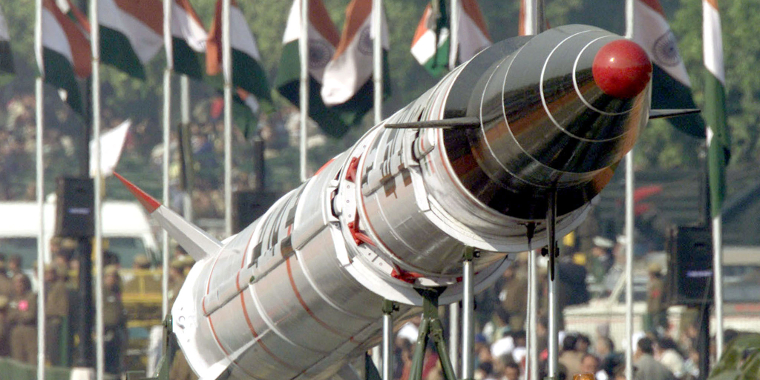The Nuclear Nonproliferation Treaty
What is the NPT and how has the treaty influenced the spread of nuclear weapons?
What is the Nuclear Nonproliferation Treaty?
The Treaty on the Nonproliferation of Nuclear Weapons, known commonly as the Nuclear Nonproliferation Treaty (NPT), is a landmark international treaty and the foundation of nuclear nonproliferation. Nuclear nonproliferation refers to the tools and policies used to diminish or eliminate the spread of nuclear weapons. The NPT’s goals are to
- Prevent nonnuclear countries from getting nuclear weapons,
- support peaceful nuclear energy use, and
- lead to eventual nuclear disarmament in countries that already possess nuclear weapons.
What led to the creation of the NPT?
The United States was the first country to use atomic weapons. In the final days of World War II, it dropped two bombs on the Japanese cities Hiroshima and Nagasaki, killing tens of thousands of people in a matter of minutes. (Survivors of the blast and children of pregnant survivors faced increased rates of cancer in ensuing years.) Less than six months later, in 1946, the UN General Assembly called for the total elimination of nuclear weapons.
Yet over the next twenty years, as UN representatives deliberated over how to prevent the proliferation, or spread, of nuclear weapons, four more countries obtained nuclear weapons: the Soviet Union, the United Kingdom, France, and China.
By August 1967, after many negotiations, the United States and the Soviet Union submitted a draft nonproliferation treaty to a UN committee focused on disarmament. The Cold War was in full swing, and all eyes were on the two countries; together they held most of the world’s nuclear weapons and viewed each other as an existential threat. Over the next several months, the draft was revised to reflect nonnuclear countries’ concerns, such as eventual elimination of nuclear weapons. The General Assembly then opened the treaty for signature in July 1968.
Which countries joined the NPT (and which countries didn’t)?
Fifty-nine countries signed the NPT when it opened for signature; the treaty now has 191 parties. Yet despite that nearly universal agreement, the number of countries with nuclear weapons has grown.
When the treaty was opened for signatures, only five countries were identified as “nuclear-weapon states.” Today however, four more countries, which are not party to the NPT, possess or are believed to possess nuclear weapons: India, Israel, Pakistan, and North Korea. (While the first three never joined the treaty, North Korea joined the NPT in 1985 but withdrew in 2003.)
Is the NPT a success?
Reviews of the NPT are mixed. Some experts say the NPT has helped create a norm, or acceptable rule of behavior, around nuclear power use by putting the goal of nonproliferation into writing. But others say the NPT is not as influential as it’s believed to be. And countries that have joined the treaty disagree on how effective it actually is at preventing nuclear proliferation. Here is how the NPT measures up to its goals:
Ongoing challenges with preventing the spread of nuclear weapons
Although the number of nuclear weapons in the world has shrunk since its peak in the 1980s, more countries have nuclear weapons now than before. Also, the NPT does not address the possibility of nuclear weapons falling into the hands of terrorist groups. Such a threat exists in a nuclear-armed country like Pakistan, where terrorist groups can operate relatively freely and those seeking to acquire nuclear weapons could have easier access to them.
Supporting peaceful nuclear energy use
The NPT encourages countries to provide each other with nuclear materials for peaceful purposes, such as harnessing alternative energy sources. But it doesn’t provide a strong safeguard against rogue countries using nuclear technology to develop weapons. To address those shortcomings, additional conditions have been added to the treaty and accepted by 136 countries. Those extra rules allow the International Atomic Energy Agency, the UN agency tasked with monitoring peaceful nuclear power use worldwide, to make surprise inspections at nuclear enrichment sites to ensure those sites are not being used to build weapons. But not everyone has agreed to those rules.
Achieving nuclear disarmament
Several countries, such as Argentina and Brazil, considered launching nuclear programs and eventually decided against doing so. Meanwhile, South Africa created a stockpile and then destroyed it, and countries such as Ukraine transferred the weapons they had to Russia. Still, the five countries that had nuclear weapons when the treaty went into effect—the United States, China, France, Russia, and the United Kingdom—still maintain sizeable nuclear arsenals, and many countries without nuclear weapons argue it’s unfair that the nuclear weapons states have not yet disarmed.
Because of these gaps in the NPT, many countries have signed separate agreements and treaties of their own.
The reality of living in a world with nuclear weapons means some countries want protection from nuclear weapons even if they ultimately believe in the goal of nonproliferation. One way countries handle this dilemma is by agreeing to security guarantees, usually pledges from a nuclear-armed country to protect non–nuclear armed allies in the event of an attack.
Other countries want more control over nuclear weapons and materials than the NPT offers, so they draft agreements with countries that share similar goals to tackle specific issues related to nuclear power. Australia, for example, has agreements with nineteen countries to guarantee that any uranium it sells to them is used only for peaceful purposes and is not transferred to third parties.
The future of the NPT
Although newer agreements address specific issues that the NPT’s framework does not, they haven’t yet replaced the NPT. In addition, countries that are party to the NPT are continuously working to improve it: every five years, the parties meet to discuss how to achieve the treaty’s goals of nonproliferation and eventual disarmament, a practice that gives this foundational agreement fresh air and room to grow.
